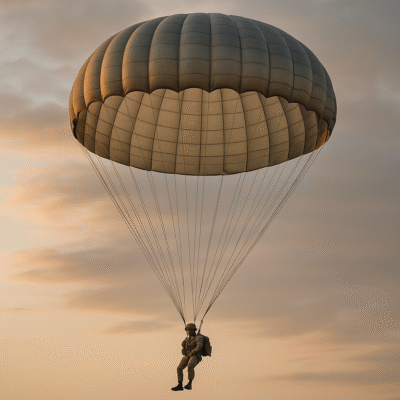When the mission is critical and the margin for error is razor thin, only the most advanced gear will do. For airborne units around the globe, high performance military parachutes are not just equipment—they are life-saving systems that ensure a safe, strategic insertion into hostile or demanding environments.
At Aerodyne, we design and supply military parachute systems that exceed performance standards in altitude, accuracy, safety, and durability. Trusted by elite airborne forces and defense agencies worldwide, our products are engineered for peak performance in the most unpredictable conditions.
In this article, we’ll explore what defines a high-performance military parachute, how Aerodyne’s systems meet those standards, and the gear that makes the difference between mission success and failure.
What Makes a Parachute “High Performance”?
High performance military parachutes are built to do more than simply descend from the sky. These systems are engineered to:
Withstand high altitudes and rapid deployments
Enable accurate, steerable landings in complex terrains
Integrate with modular military accessories
Operate reliably in extreme climates and wind conditions
Support high-weight loads including equipment, cargo, and rucksacks
Whether used in HALO/HAHO operations, tactical insertions, or rapid response scenarios, high performance parachutes must deliver unmatched stability, strength, and survivability.
Key Features of Aerodyne’s High Performance Military Parachutes
1. Steerable Canopy Design
Parachutes like the MC1-1C feature a steerable canopy, allowing paratroopers to maneuver during descent, avoid obstacles, and land with precision. This is essential for special operations forces and units deploying into tight or hostile landing zones.
2. Advanced Canopy Materials
Aerodyne utilizes MIL-C-7020 T1 1.1 oz ripstop nylon in the construction of our canopies. This fabric is:
Tear-resistant
Lightweight
Flame-retardant
UV-resistant
These properties ensure canopy longevity and safety—even after multiple uses or exposure to extreme environments.
3. Aerodynamic Stability
The MC1 and M7 Tactical Parachute systems are shaped and weighted to reduce oscillation, enhance descent control, and minimize impact upon landing—critical factors in high-stakes insertions.
See related article: Understanding Airborne Parachuting Techniques
4. Modular Load Integration
Aerodyne parachutes are designed to integrate with:
Breakaway rucksacks
Oxygen delivery systems
Thermal suits
Weapon retention holsters
This ensures that personnel can deploy with full combat readiness and confidence.
Aerodyne’s Flagship High Performance Systems
MC1 Series – Steerable Tactical Parachutes
Engineered for tactical applications, the MC1 series provides full maneuverability and stable flight, ideal for both training and real-world insertions.
Altitude Range: 800 to 25,000 feet
Landing Accuracy: Within 25 meters of target
Canopy Area: 370 sq ft
M7 Tactical Parachute System
Our most advanced freefall canopy, the M7 is tailored for special operations. Built for HALO and HAHO jumps, the M7 provides maximum glide control, steering authority, and payload integration.
Operational Altitude: Up to 35,000 feet
Load Capacity: Up to 400 lbs (person + gear)
Deployment Type: Manual or static line with modular reserve system
Performance in Real-World Conditions
Aerodyne’s high performance military parachutes are battle-tested and field-deployed across:
Desert combat zones
Arctic surveillance missions
Jungle warfare training
Maritime reconnaissance
Our systems are used by over 30 defense organizations worldwide, making Aerodyne a globally trusted name in military airdrop performance.
Learn more: Military Parachute Systems
The Importance of Testing and Certification
Every Aerodyne parachute undergoes rigorous testing that includes:
Wind tunnel simulations
Drop testing from multiple altitudes
Material fatigue analysis
MIL-STD-858 compliance
NATO STANAG 2338 compatibility
This ensures every system is ready for deployment the moment it’s needed.
Best Practices for Using High Performance Military Parachutes
1. Train With Full Loadout
Jumpers should train with the full operational kit to simulate real-world scenarios. Aerodyne’s training chutes mirror operational gear for continuity in performance.
2. Conduct Routine Inspections
Always inspect canopy integrity, rigging lines, and release systems. Even the best parachute needs routine care.
Recommended: Tips for Extending the Life of Your Parachute
3. Know Your Insertion Environment
Adjust canopy type and load configuration based on terrain, altitude, and mission duration.
Why Aerodyne Is a Global Leader in High Performance Parachutes
✅ Proven Combat Record
Aerodyne products are used in both training and active-duty environments, making them a top choice for military organizations globally.
✅ Modular System Compatibility
Our gear integrates seamlessly—parachutes, accessories, harnesses, oxygen systems, and more.
✅ Support You Can Trust
From training manuals to field support and technical consultation, Aerodyne partners with every client from selection to deployment.
Contact Us Today to Learn More
If you’re seeking high performance military parachutes that offer unmatched reliability and customization, Aerodyne is your trusted supplier. Our systems are tailored to the operational needs of today’s military—whether you’re preparing for your next HALO jump or deploying into a tactical scenario.
Explore our full product range on the Home Page or Contact Us today to discuss your mission requirements.
Aerodyne: Engineered for altitude, trusted for performance.
